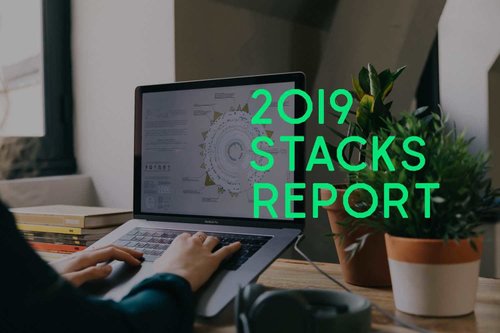How to Create a Personal Blog as a Developer
11. 6. 2019
8 min.


Lead JavaScript software engineer @ Ferpection
Many developers have thought about starting a blog at some point in their career but few of them actually get round to doing it. Often it’s because of concerns like “What on earth could I say about this? I’m not the best on this topic,” or “I won’t be able to deal with the haters’ comments,” or even “I’m a coder, not a writer. I don’t know how to write a publication.”
However, starting a blog could bring many advantages. When you write on the Internet you become more visible than a regular developer. Who are you hoping will read your post? Future colleagues? A recruiter from that awesome company you’d like to work at? The committee responsible for choosing the speakers of a conference you’d like to talk at? All these people will be interested in both your technical skills and your editorial skills.
Also, what better way is there to learn than by explaining to other people? That’s exactly what you’ll be doing when you write a technical post on your blog.
So now we’ve convinced you that starting a blog is what you want to do, how should you go about it?
Choose where you want to write
Before starting to write, you need to choose where your posts will live. Should you write on an external platform such as Medium? Should you select an open-source project such as WordPress? Or should you build your own platform? All three options have pros and cons.
Use an external platform
Medium is an awesome platform, where a lot of people write amazing stuff. You’ll have nothing to configure, meaning you can start straight away. You’ll also have access to thousands of potential readers already using the platform.
Everything seems easy, but no configuration also means no customization. Do you want to integrate with StackBlitz or GitHub? You won’t be able to if the Medium team isn’t interested in that. Another thing to consider is your readers aren’t your users but Medium’s. They come to read your thoughts but they give their money to Medium, meaning you’ll be working for free (almost). The last point about Medium, and by no means the least, is that it is not your website. That’s to say, if at some point Medium decides to kick you off of its platform (it has happened to some people), you’ll lose everything—the easy-to-use platform, the thousands of readers, and so on. Medium doesn’t care about your business model.
Configure an open-source solution
Using an open-source solution is often a good choice because nowadays the existing ones are fairly easy to use, even if they need a few configurations. We’re only going to be talking about WordPress and Ghost in this post because the former is the most-used platform (as at March 2018, more than 30% of the Internet were using it) and Ghost is the outsider that has been steadily stealing WordPress users.
With WordPress or Ghost, or other open-source projects, you’ll own your data. Of course you won’t have the existing Medium audience and you’ll have to work hard to build your own community, but in return, your readers will be your users and your business won’t have to depend on an external company.
Your choice of open-source platform should be led by what you really want to do. WordPress was built for bloggers but evolved in such a way that you can do almost everything with it now, which makes it the obvious choice if you plan to do more than blogging. It’s highly extendable thanks to its plug-in system. If you only want to blog, though, we can’t emphasize enough that you should try Ghost. It may only do one thing, but it does it well. Everything you need to blog is built into it, including a beautiful and powerful editor, social and SEO capabilities, and speed and performance.
Build a platform from scratch
The third option is to build your platform from scratch. This solution is only right for people who know exactly what they want to do and have the time. Building a platform is really time-consuming because you’ll not only have to create content and build your community, you’ll also have to be responsible for the coding of the platform where your content will be read.
However, your website will work exactly the way you want. You’ll have full control of the content, the way it is displayed, and the way the content is reached. Also, your website will be your side project. You’ll learn a lot and you’ll grow as a developer. It’s also a way to show your community and other people, such as recruiters, what you can do. This is the real advantage to building your own platform, because it will give you credibility when you talk about development topics on your blog.
If building a platform is sounding too time-consuming, you could mix it up and start with a hybrid of the above options. For example:
- to own your data, go with an open-source project,
- and to build your platform, go for a front-end app that works with an open-source project API (or a template for WordPress/Ghost).
Hybridizing can have a lot of advantages. To learn more about the one we’ve suggested here, browse for “JAMstack”.
Talk about what you know
Once you know where you’re going to write your posts, you’ll need to know what you want to write. Here are a few tips before you start working on the crux of the content.
Always aim to write an intro and a conclusion as a recap of the important ideas you talked about, and have someone read what you’ve written before posting it, to track any spelling or grammar mistakes. Also, keep the same tone in all your posts for coherence.
We know you’ll write about technical stuff but the purpose of your blog won’t be to publish 3 posts only. You need to find inspiration if you’re going to keep posting regularly for a long time. At the beginning it’s easy to write because we write about what we know. We already have a lot of things to talk about, and that’s good! But a time will come when you find you’ve run out of topics. That’s why you need to keep coding.
If you have an exciting job it will be easy to find topics to write about. Take a look at the personal blog of Dan Abramov, the main developer of React.js. He talks about… React.js!
If you don’t have an exciting job, there is a way to solve your problem: Side projects. If you want to write a blog about technical topics, finding interesting projects will help you to come up with content. You can keep notes of all the research you do during the creation process and turn these into a post afterwards. If you want to have exclusive content, try to write about things that rarely get talked about.
Your blog will grow with your knowledge. Whatever the topic of your post, you need to practice what you’re talking about if you’re going to be able to continue to talk.
A gentle reminder: As a developer you don’t have to just write about code or technical, computer-engineering stuff. Talk about what inspires you. Talking about social biases in the coding industry is OK, too.
Talk often
To build your community, taking care of your content should be a priority, but even more should be when you publish it and how many times.
This is part of SEO: Search engines love unique content. The more you feed them with your content, the better the love they show you and the higher they rank your blog. That being said, there’s no need to publish 10 posts a day to have an awesome blog.
Many bloggers publish 1 to 3 posts a week; it’s up to you to decide how many times you want to post each week. Regularity is key. Also, keep in mind your readers are mainly human beings—only a small amount of them will be bots—so make things easy for them: Create a publishing routine. We cannot stress it enough—you need to be regular. Choose a day and time when you want to post, and post at the same time on this day every week. Your readers will notice this schedule. They will come back to read your thoughts every week! Soon, you’ll notice a peak in your stats on the day you’re due to publish, even if you don’t end up publishing.
To be able to keep to your schedule without being overwhelmed, a pro-tip is to schedule your writing sessions on your calendar. Obviously, the amount of time you dedicate to this task depends on how many posts you want to publish each week. It could be an hour on Sundays, or even an hour each weekday. It’s up to you.
Once you’ve decided on your writing schedule you have to stick to it. This advice is valid, even if you already fulfilled your quota of posts for the week. Why not use the time to start writing next week’s posts? The more you get done in advance, the less stressed you’ll be by the time the deadline approaches. This is a good thing, because stress hinders creativity, and you need creativity to write awesome posts.
In order to reduce (or not increase) your level of stress and keep your posts regular, avoid using analytics when you start blogging. Or rather, install the tools but avoid checking them during the first few months, because it is more than likely that you won’t have a lot of traffic at the beginning. The numbers could daunt you, so focus on the content.
Share your thoughts
Social media is key to making your blog a well-read platform. The more platforms the merrier? Not necessarily. Choose wisely: Some are irrelevant because developers don’t go there to read tech stuff. So don’t waste time juggling 36 social-media accounts. More than anything else, you’ll need this time to write great posts and work on your awesome side projects!
Sharing is caring, so share your posts often. No one likes to talk to themselves. To avoid disappointment with the reaction to your blog at the start, which may lead you to think about closing it after 2 weeks, share your posts with your family, friends, and acquaintances. There’s no easier way to do that than with social media.
The key social-media platforms have their own uses. On Twitter, for example, since the posts scroll rapidly out of sight, you can share the same links to your blog multiple times a day. It is always possible that one of your followers spends their whole day on Twitter and will see the same link several times, so try to use different descriptions with them. You can also retweet people who have retweeted and commented on your posts, which will make them appear in your feed. This is a way to maintain a steady flow of readers. Keep in mind that even if the post already appeared on social media 2 months previously, not all your followers who might be interested in it will have seen it, so repost it.
On LinkedIn, the rules are different. One link a day redirecting to your own blog is great, other posts should be kept as discussions with your peers.
With time you’ll work out how best to work with each platform.
Use your network
We developers have a big asset that we can use to our benefit: Programming is a niche market with highly engaged members. Websites such as Hacker News, Dev.to, Medium, and tech subreddits are places packed with developers hungry for great technical posts to read, so feed them yours and use those websites to get known.
On Hacker News and subreddits, you can send your links with a description. On Medium and Dev.to you have to write a post: Just copy and paste your blog posts (with canonical links to your original post) to create interest and draw developers from these platforms to your own blog. You can also make guest posts on Medium or Dev.to publications that already have lots of readers, such as HackerNoon. You’ll find a lot more places like this on the Internet. Using them is important.
Engage with your community
At this point, you already share your posts everywhere, but it’s not enough! Ask questions, answer comments, talk about your work, your daily life, make videos if you feel comfortable doing so. Your readers are developers, so they are human beings too. People need to be able to relate to you to build a sense of community. An engaged reader will help greatly by sharing your posts on social media, commenting, giving you feedback… Value those readers by taking the time to thank them! If you get some negative feedback or the content is not interesting enough for your readers, just try something else.
What to do now?
- Choose your blogging platform according to what you want to do.
- Fix a posting schedule to keep your readers coming back to your blog.
- Write your first post and share it with your friends and on social media.
This article is part of Behind the Code, the media for developers, by developers. Discover more articles and videos by visiting Behind the Code!
Want to contribute? Get published!
Follow us on Twitter to stay tuned!
Illustration by Brice Marchal

Viac inšpirácie: Career hacking
Because being a developer is not just about coding, we want to share dedicated tips on soft skills and career paths, help you stay up-to-date with your favorite technologies, and learn more about the job market.

Computing’s Gender Divide: Why Tech Is Stuck in the 1980s
Discover why the percentage of women who held computing-based jobs has been in a steady decline since the 1980s.
14. 9. 2020

5 Remote-work Lessons From the Open-source Community
The open-source movement has a few things it can share about remote working with the wider software-development community.
09. 6. 2020

2019 Stacks Report
The most-mentioned technologies in the job specifications published on WTTJ's website in 2019 and the average number of applicants per technology.
21. 4. 2020

Engineering Management: An Interview with Saad Rehmani
Saad Rehmani, the VP of Engineering at Reddit, shares his most effective management strategies to handle the COVID-19 crisis.
07. 4. 2020

Engineering Management: An Interview with Rich Archbold
Rich Archbold, the VP of Engineering at Intercom, explains how to develop a management style and how to transition to managing other managers.
17. 3. 2020
Novinky, ktoré to vyriešia
Chcete držať krok s najnovšími článkami? Dvakrát týždenne môžete do svojej poštovej schránky dostávať zaujímavé príbehy, ponuky na práce a ďalšie tipy.

Hľadáte svoju ďalšiu pracovnú príležitosť?
Viac ako 200 000 kandidátov našlo prácu s Welcome to the Jungle
Preskúmať pracovné miesta